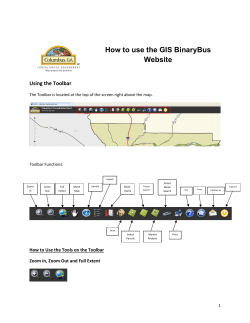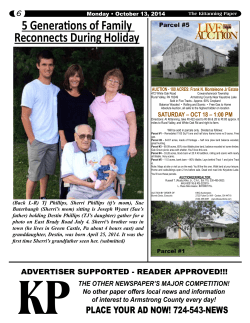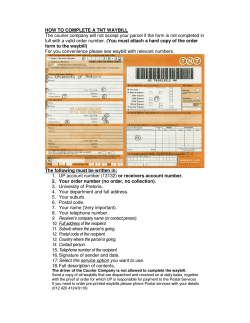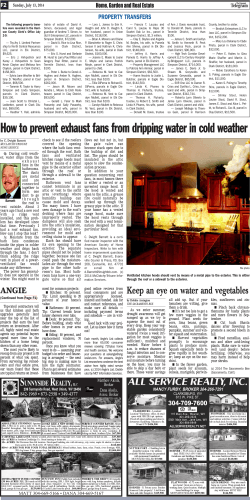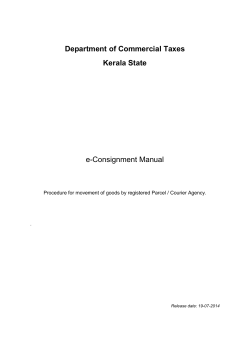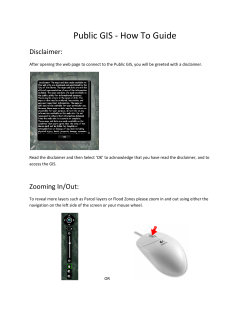
View/Open - AgEcon Search
The Impact of Parcel Structure on the
Ef iciency of Finnish Dairy Farms
Olli Niskanen and Anna-Maija Heikkilä
In Finland, expanding dairy farms often face the problem of additional ields being
geographically distant and only available as small parcels. We develop a stochastic
production frontier model to estimate the technical ef iciency of Finnish dairy
farms and simulate the effect of parcel distance and parcel size on the ef iciency
of an average farm for 2000 through 2009. The overall development of technical
ef iciency is positive during the study period but increases in distance and
decreases in parcel size both signi icantly reduce farm ef iciency. Therefore, efforts
to improve the parcel structure are justi ied.
Key Words: milk production, parcel structure, stochastic frontier, technical
ef iciency
Land is a fundamental input in agricultural production. Therefore, the availability
and parcel structure of agricultural land are essential factors in investment
decisions and efforts to expand operations. Expansion, in turn, is a means
by which farmers try to improve their productivity and productivity growth.
Productivity growth is also one of the main objectives of the Common
Agricultural Policy (CAP) in the European Union (EU) (Meester 2011).
In Finland, agricultural areas occupy a smaller proportion of the total land
area (9 percent) than in most European countries and the area occupied
by lakes and water courses is large (11 percent), resulting in small, often
irregularly shaped areas of agricultural land. Also, almost all of Finland’s
agricultural land is located above a latitude of 60 degrees north. The country
is divided into support areas to offset pro itability differences between more
and less favorable agricultural regions. The AB region represents southernmost
Finland, which is more suitable for agriculture. Regions C1, C2, C3, and C4
represent progressively northerly areas in which growing seasons are shorter
and temperature sums are lower than in the south.
The structure of the Finnish dairy sector has changed dramatically in
recent years and will continue to change in the near future. Milk production
is concentrating in larger, more capital-intensive units to improve the
competitiveness of the dairy sector. The number of dairy farms is likely to
decrease from about 9,000 in 2012 to less than 6,000 by 2020 (MTT 2014), and
this concentration has had a major effect on the demand for land and on land
prices (Pyykkönen 2006).
Olli Niskanen is a research scientist and Anna-Maija Heikkilä is a principal research scientist in the
Department of Economics and Society at the Natural Resources Institute Finland. Correspondence:
Olli Niskanen Natural Resources Institute Finland Latokartanonkaari 9, FI-00790 Helsinki Phone
+358.29.532.6000 Email olli.niskanen@luke. i.
The authors are grateful to research scientist Eeva Lehtonen for her work with parcel distance
calculations and the Business Analytics team for providing the data necessary for the research.
The project received inancial support from the Finnish Ministry of Agriculture and Forestry,
which is gratefully acknowledged. The views expressed are the authors’ and do not necessarily
represent the policies or views of the sponsoring agencies.
Agricultural and Resource Economics Review 44/1 (April 2015) 65–77
Copyright 2015 Northeastern Agricultural and Resource Economics Association
66 April 2015
Agricultural and Resource Economics Review
In Finland, a farmer has to apply for an environmental permit to expand
animal production. One of the requirements for the permit is a minimum area
of land that must be available for spreading manure. Currently, the required
area is 0.77 hectares per cow, 0.29 hectares per heifer (12–24 months of age),
0.22 hectares per female calf 6–12 months of age, and 0.09 hectares per female
calf less than 6 months of age. Owning or leasing the area is not necessary;
it is possible to meet the requirement through manure-spreading contracts
with other farmers (Environmental Administration of Finland 2000, Finnish
Ministry of the Environment 2010). In environmental permits granted in 2009
through 2012, the dairy expansions often were large, doubling or tripling an
operation’s milk-production capacity. Consequently, the availability and price
of land restricted expansion in some cases. Clearing of arable land also has
increased in areas in which milk production is most concentrated.
Milk production is characterized by a close link to arable farm land, not
only because of manure requirements but also due to a need to produce feed.
Farms usually produce most of their own feed or buy it locally. Ruminants
need rough feeds in their diets, and self-suf iciency in provision of roughage
is typically a minimum requirement for milk production (Sipiläinen 2007).
A single farm in Finland usually operates a large number of small land parcels
that are located some distance from the primary farm compound (Myyrä and
Pietola 2002). In addition, because of comparative advantages, Finnish dairy
production is concentrated in northern Finland, which has the greatest amount
of fragmentation of parcels (support areas C1 and C2 in particular).
Del Corral, Perez, and Roibas (2011) summarized negative effects associated
with parcel distance, which induces a lack of labor productivity as well as
higher transport costs for inputs and outputs. Since a single cow annually
requires close to ten tons of roughage feed (wet matter) and produces 24 cubic
meters of manure, parcel distance plays an important role in the logistics of
a dairy farm. Moreover, high-quality silage requires good timing in terms of
harvesting, which is made more challenging when a bigger share of resources
must be spent transporting the harvest.
Another component of land fragmentation is parcel size. Compared with large
rectangular ields, small parcels make less ef icient use of machinery (Buller
and Bruning 1979) or can entirely prevent the use of highly ef icient modern
technologies. Small parcels also may have a relatively large share of edges
overshadowed by adjoining woods or drainage problems that affect yields, both
of which reduce the economic performance of the farm. Indeed, Myyrä and Pietola
(2002) suggested that it is likely that the smallest parcels are eventually left idle
or kept as set-asides even on farms that specialize in cattle rearing or dairying.
Currently, one-third of all Finnish ields are cultivated as leases-outs, often
under relatively short contracts that do not motivate the lessee to invest in
renovation or drainage to improve the usability or the size of individual parcels.
A farmer looking to expand often requires every available parcel in the area,
even the smallest ones. Thus, ongoing structural development increases the
farm’s size but parcel size remains practically stagnant (Myyrä and Pietola 2002).
Industry analysts have wondered, therefore, whether expanding an operation’s
size results in greater productivity. Bene its that arise from the increase in farm
size may not be entirely realized due to growing fragmentation (Hiironen 2012).
However, this question has not been analyzed empirically.
We estimate the technical ef iciency of Finnish dairy farms by focusing
on the impact of parcel structure—how much of potential ef iciency is lost
Niskanen and Heikkilä
Impact of Parcel Structure on Finnish Dairy Farm Ef iciency 67
because of small parcel sizes and long parcel distances. The connection
between land fragmentation and ef iciency has been previously studied
for crop production in China (Wu, Liu, and Davis 2005, Tan et al. 2010),
Bangladesh (Rahman and Rahman 2008), and India (Manjunatha et al.
2013). Del Corral, Perez, and Roibas (2011) analyzed the impact of land
fragmentation on productivity and pro its for Spanish dairy farms. However,
there are many differences in how dairy cows are fed and manure is handled
in Spain versus the northernmost countries of Europe so the impacts of
land fragmentation may also differ. Moreover, Del Corral, Perez, and Roibas
(2011) measured land fragmentation by number of parcels but ignored area
and distance. The empirical data used in our study allow us to analyze the
effects of size and distance on ef iciency.
Material and Methods
Stochastic Production Frontier Model
The objective of producers can be as simple as obtaining maximum outputs
from given inputs or minimizing input use in production of given outputs.
Producers operating on their production frontiers are labeled as technically
ef icient and producers operating at less than that level as technically inef icient
(Kumbhakar and Lowell 2000). The stochastic production frontier model that
appears in the current literature was originally developed by Aigner, Lovell, and
Schmidt (1977). Several improvements have since been made. For example,
Battese and Coelli (1992, 1995) introduced a production frontier model for
panel data. Following Battese and Coelli (1995), we can express the stochastic
production frontier as
(1)
Yit = β΄xit + vit – uit
where Yit is production and Xit is a vector of production inputs (see Table 1). β΄ is
a vector of unknown parameters to be estimated, and i and t denote a farm and a
time period, respectively, so that the ef iciency scores can vary from year to year.
In the model, vit is an error term that is assumed to be identically distributed
(N(0, σ2v)) and distributed independently of uit, which is a vector of nonnegative random variables associated with technical inef iciency of production.
The error term vit captures statistical noise and other stochastic shocks. The
one-sided disturbance term uit represents deviation of each irm from the
technically ef icient frontier, factors that are under the control of decisionmakers, whereas the two-sided error term vit represents uncontrollable factors
that indicate whether the frontier can vary randomly across irms. We assume
that uit is independently distributed such that uit is obtained by truncation (at
zero) of the normal distribution with mean δ΄zit and variance σ2v. In the model,
zit is a vector of farm-speci ic inef iciency variables that may change over time
and δ΄ is a vector of unknown coef icients. In the stochastic frontier model, uit
can be speci ied as
(2)
uit = δ΄zit + wit
where zit is a farm- and time-speci ic vector of values that explain inef iciency,
δ΄ is a vector of parameters to be estimated, and wit is obtained by truncation of
68 April 2015
Agricultural and Resource Economics Review
the normal distribution with zero mean and variance σ2v such that the point of
truncation is –δ΄zit (Battese and Coelli 1995).
The technical ef iciency (TE) describes the ratio of observed output to
maximum feasible output, and TE of production is de ined as
(3)
TEit = exp(–uit) = exp(–δ΄zit – wit).
Because the observed output is always less than or equal to the maximum output,
the TE index is restricted between 0 and 1. TE achieves its upper bound when
a farm produces the maximum technologically feasible output given the input
quantities.
Empirical Data and Model
The empirical results are based on a panel data set of specialized Finnish dairy
farms in the European Commission’s Farm Accountancy Data Network (FADN).
Farms were designated as dairy farms when more than two-thirds of their
standard output originated from milk production. The research period covers
the years 2000 through 2009, and the data form an unbalanced panel with 568
individuals and 3,329 observations.
Production frontiers of both the translog (e.g., Byma and Tauer 2010, Alvarez,
Del Corral, and Tauer 2012) and Cobb-Douglas type (e.g., Cabrera, Solis, and
Del Corral 2010) have been applied to milk production. The translog function is
more lexible but, with our unbalanced panel data, it suffers from monotonicity
violations (e.g., Chambers 1988). These two function types produce equally
signi icant parameter estimates, the values of which are very close to each other.
Consequently, the key results are robust to the choice of model. Our empirical
analysis is based on a Cobb-Douglas-type production function that expresses both
outputs and inputs in logarithmic form. Time dummy variables were included
in the production function as an indicator of neutral technical change (Baltagi
and Grif in 1988). In addition, regional dummy variables in the model capture
the effect of spatial differences in the production environment. Likelihood ratio
tests indicated that the presence of both dummy variables improved the it of
the model (p < 0.001). Their inclusion in the production function represents an
assumption that they directly affect the shape of the frontier but not the distance
from the frontier. In this case, TE is net of effects related to technical change
and the production environment. This assumption is in line with the results of
Sipiläinen and Ryhänen (2005), which estimated a stochastic production frontier
for Finnish production of grass silage with various model speci ications.
Since the farms in our data set specialized in milk production, we followed
the method introduced by Alvarez, Del Corral, and Tauer (2012) and converted
all non-milk outputs to milk liter-equivalents by dividing the revenue from the
items by the price of milk. The average producer price of milk was used in the
conversion. The inputs are capital stock, land area, labor hours, and cost of
materials and supplies. All monetary values are presented with ixed 2010 prices.
Market returns were de lated with the producer price index, capital values
with the consumer price index, and material costs with the input price index of
agriculture, all from Statistics Finland (2013a, 2013b). The producer price of
milk was obtained from Tike (2013).
Table 1 presents descriptive statistics for the variables in the frontier model,
and Table 2 provides data on arable area, parcel size, and distance for 2000
Niskanen and Heikkilä
Impact of Parcel Structure on Finnish Dairy Farm Ef iciency 69
through 2009. The data for parcel size and distance were obtained from the
parcel register maintained by the Finnish Agency for Rural Affairs (MAVI),
which collects the information to manage and control area-based CAP supports.
The distance from a farm compound to the middle of each parcel was calculated
from coordinate information with a Pythagorean equation:
(4)
D=
(x1 – x2)2 + (y1 – y2)2
where (x1, y1) and (x2, y2) are the x and y coordinates of the farm compound
and the parcel’s middle point, respectively, and D is distance. The coordinates
Table 1. Descriptive Statistics of Production Frontier Model Variables
Variable Description
N
Sum
Mean
Std. Dev.
Total market return, euros
3,329
—
104,054
74,204
Milk output, liters
3,329
—
235,093
170,012
Output, equivalent to milk liters
3,329
—
270,880
194,027
Capital stock, no ag. land area, euros
3,329
—
312,462
294,009
Land area, hectares
3,329
—
55.6
32.7
Labor, hours
3,329
—
5,123
1,892
Cost of materials and supplies, euros
3,329
—
103,303
76,503
Binary variable, region AB
—
598
0.18
—
Binary variable, region C1
—
727
0.22
—
Binary variable, regions C2–C2P
—
1,578
0.47
—
Binary variable, regions C3–C4
—
426
0.13
—
Table 2. Development of Average Arable Area, Parcel Size, and Distance
for 2000–2009
Total
Arable Area
in Hectares
Parcel Size
in Hectares
Weighted
Parcel Distance
in Meters
Arithmetic
Parcel Distance
in Meters
Number of
Parcels
2000
43.4
2.49
1,937
4,646
20
2001
46.2
2.45
2,028
4,743
21
2002
47.6
2.45
1,931
4,600
22
2003
49.2
2.45
1,811
4,405
23
2004
51.6
2.48
1,898
4,613
23
2005
57.0
2.45
2,030
4,956
26
2006
59.0
2.48
2,100
5,141
26
2007
62.2
2.53
2,155
5,447
27
2008
66.4
2.57
2,321
5,991
28
2009
70.3
2.59
2,326
6,001
30
70 April 2015
Agricultural and Resource Economics Review
were from the Finnish Basic Coordinate System (Finland Zone 3), a rectangular
plane coordinate system (Ollikainen and Ollikainen 2004). For small distances,
the cosine correction for the shape of the globe was not considered necessary.
Weighted distance (average distance of a ield hectare) can be used when
one needs to describe a parcel structure with a single value (Suomela 1950)
and gives more reliable information about a parcel’s structure than an average
arithmetic distance, which might be disturbed by a single small parcel located
at a long distance away. We calculated average parcel distance as farm- and
time-speci ic by multiplying the parcel’s size by the mean parcel distance and
then dividing that product by the total area of the farm.
In the distance data, some utmost observations were considered to be
outliers. A typical outlier was a farm that had two or more separate compounds
located a long distance from each other. Another example is a farm that had a
completely separate single ield parcel far from the farm. This sort of ield could
be completely cultivated by a contractor and would not necessarily have much
to do with the farm’s production of roughage or manure logistics. Altogether, 30
of the 568 farms included parcels that were more than 50 kilometers from the
primary compound and were excluded from the data.
In the inef iciency model, the average distance to parcels and average size
of parcels were supplemented with the squared and crossed values of those
variables. Dummy variables were used to capture the effects of the (i) type of
production (organic and conventional) and (ii) type of housing for cows (loose
housing and tied housing).
Table 3 presents descriptive statistics for the variables in the inef iciency
model. The estimated coef icients of this model were further analyzed with
a simulation model to examine the in luence of distance and parcel size on
ef iciency in greater detail. We followed the method used by Del Corral, Perez,
and Roibas (2011). First, we constructed an average farm from the mean
values of inputs (capital stock, land area, labor hours, and cost of materials and
supplies) and ef iciency determinants for 2000 through 2009. The production
type of the average farm was ixed as conventional and the housing type as
free-stall. Next, the expected TE score was calculated for the average farm using
the estimated parameters of the stochastic production function. Furthermore,
we varied the weighted average parcel distance and average parcel size in the
simulation, ceteris paribus, from 50 percent to 200 percent of their means. As
a result, the ef iciency score of the average farm could be presented by parcel
Table 3. Descriptive Statistics of Inef iciency Model Variables
Variable Description
N
Sum
Mean
Std. Dev.
Average weighted parcel distance,
meters/hectare
3,329
—
2,060
1,898
Average parcel size, hectares
3,329
—
2.5
1.21
Binary variable, production type,
1 = organic, 0 = conventional
—
228
0.07
—
Binary variable, housing system,
1 = loose, 0 = tied
—
753
0.23
—
Niskanen and Heikkilä
Impact of Parcel Structure on Finnish Dairy Farm Ef iciency 71
distance and parcel size. NLOGIT software version 5 (Econometric Software,
Inc., Plainview, New York) was used in the estimation.
Results
Production Frontier Function
The results of the stochastic production frontier model are presented in Table 4.
The dependent variable is total output in milk liter-equivalents. All of the input
variables in this model had a positive effect on production (p < 0.001). In the
case of the Cobb-Douglas-type function, elasticities for the inputs could be
obtained directly from the irst-order coef icients. The input with the largest
elasticity was materials (greater than 0.55) and the smallest was land area (less
than 0.08). Neutral technical change captured by the time dummy variables was
1.4 percent per year on average. The regional dummy variables showed a slight
advantage in production for region C1 relative to northern regions (C2–C2P
and C3–C4) and the reference area (AB in southern Finland).
Technical Ef iciency
Parcel size and parcel distance separately induced inef iciency but their
interaction had no effect on it (Table 4). As expected, larger parcels and smaller
distances decreased inef iciency. Parcel distance and its squared term were both
signi icant determinants of inef iciency. Parcel size affected inef iciency but its
squared term did not. The impact of organic production was not signi icant but
free-stall housing decreased inef iciency signi icantly.
The overall average TE score was 79 percent with a standard deviation of
12 percent. During the research period, a small improvement in ef iciency was
detectable. The mean score was 78.3 percent in 2000 and 79.8 percent in 2009.
Figure 1 illustrates milk production in each ef iciency category at the beginning
and end of the nine-year period and shows that production became more
ef icient.
The simulation results for the average farm are presented in Figure 2. The
igure reveals a curved shape of the TE score on both dimensions. Disadvantages
increase more rapidly as the parcel size falls below average. Moreover, larger
parcels have greater TEs but the growth of TE is decreasing. For distance, the
curvature is the opposite: the TE score increases more as the distance to the
farm compound declines. Our variation of the parcel size by 50–200 percent
caused variation of 0.72 to 0.85 in TE of the average farm. When the parcel
distance was varied within the same 50–200 percent range, the TE varied
between 0.84 and 0.71.
Discussion
This study investigated the effect of the size of parcels and their distance from
the primary location on the ef iciency of Finnish dairy farms. The effect of
land fragmentation has been analyzed before by Del Corral, Perez, and Roibas
(2011) and Wu, Liu, and Davis (2005) for the number of parcels and by Di Falco
et al. (2010) for both distance and number of parcels. In those studies, land
fragmentation had a signi icant negative effect on ef iciency so our results align
with those studies.
72 April 2015
Agricultural and Resource Economics Review
Table 4. Model Results
Variable Description
Coef icient
Std.
Error
Probability Signi i|z| > Z*
cance
Deterministic Component of Stochastic Frontier Model
β0
Constant
3.00296
0.09086
0.000
***
βc
ln Capital
0.16528
0.00592
0.000
***
βa
ln Land area
0.07905
0.01073
0.000
***
βl
ln Labor
0.10494
0.01037
0.000
***
βm
ln Materials
0.55216
0.00816
0.000
***
***
Binary Variable for Year – Reference Year: 2000
βt2
2001
0.03134
0.01212
0.010
βt3
2002
0.02756
0.01101
0.012
**
βt4
2003
0.03160
0.01213
0.009
***
βt5
2004
0.03946
0.01117
0.000
***
βt6
2005
0.06222
0.01066
0.000
***
βt7
2006
0.08691
0.01063
0.000
***
βt8
2007
0.11238
0.01113
0.000
***
βt9
2008
0.13013
0.01183
0.000
***
βt10
2009
0.12728
0.01148
0.000
***
***
Binary Variable for Region – Reference Region: AB, Southern Finland
βR2
Region C1
0.04294
0.01654
0.009
βR3
Regions C2–C2P
–0.01936
0.01328
0.145
βR4
Regions C3–C4
–0.07023
0.02143
0.001
***
Variance Parameters for Compound Error
λ
Lambdaa = σu / σv
2.74170
0.02585
0.000
***
σu
Sigma (u)
0.33952
0.00348
0.000
***
δ1
Average weighted parcel distance 0.08308
0.02650
0.002
***
δ2
Average parcel size
–0.10571
0.03755
0.005
***
δ3
0.5 × squared average weighted
parcel distance
–0.01380
0.00272
0.000
***
δ4
0.5 × squared average parcel size
0.01684
0.00925
0.069
*
δ5
0.5 × average weighted parcel
distance × average parcel size
0.00592
0.01331
0.657
δD1
Binary variable, production type
0.13698
0.08234
0.096
*
δD2
Binary variable, housing system
–0.14308
0.05074
0.005
***
b
Coef icients in u(i, t)
Log-likelihood
a
1,581.49
Weight of variation in technical inef iciency over variation in stochastic variable: σ = variation in the
stochastic component of the error variable.
b
u(i,t) = [exp{η × z(i,t)}] × |U(i)|.
Note: Signi icance at 1 percent = ***; 5 percent = **; 10 percent level = *.
Niskanen and Heikkilä
Impact of Parcel Structure on Finnish Dairy Farm Ef iciency 73
2000
2009
Share of Annual Milk Produc on
45%
40%
35%
30%
25%
20%
15%
10%
5%
0%
Less than
0.50
0.50–0.60
0.60–0.70
0.70–0.80
0.80–0.90
Greater
than 0.90
Technical Efficiency Category
Figure 1. Milk Production by Technical Ef iciency Categories in 2000
and 2009
0.90–1.00
Technical
Efficiency
1.00
0.80–0.90
0.90
0.80
5.0
0.70–0.80
2.7
0.60–0.70
2.3
Average Weighted Distance
(kilometers per hectare)
2.9
2.0
1.6
3.5
1.2
0.60
1.0
3.5
4.2
0.70
4.1
Average
Parcel Size
(hectares)
Figure 2. Expected Technical Ef iciency for the Average Farm
In the empirical literature, there is growing concern about endogeneity in
stochastic frontier analyses (Guan et al. 2009, Tran and Tsionas 2013). The
endogeneity problem is caused by the presence of productive factors that
affect the optimal choice of inputs for the farm that cannot be observed by the
econometrician (Marschak and Andrews 1944). In stochastic frontier analyses,
the Battese-Coelli (1995) estimator is widely used despite the inconsistent
74 April 2015
Agricultural and Resource Economics Review
parameter estimates given in the presence of endogenous regressors (Kutlu
2010). Greene (2011) pointed out that accounting for endogeneity in a nonlinear
model like the stochastic frontier analysis is dif icult and Mutter et al. (2013)
argued that there currently is no accepted approach for generating unbiased
ef iciency estimates with endogenous variables in a stochastic frontier analysis.
Mutter et al. (2013) also suggested that endogeneity and the biased
inef iciency estimates to which it gives rise will be greater as the size of the
variation between the operators increases. Our data set covered specialized
dairy farms that mostly followed a single production strategy—producing their
own roughage and spreading manure on disposable ields under environmental
permits. Thus, unobservable differences in processes and resources and the
bias associated with those differences are less of a concern.
Correlation between ef iciency and input use is possible because determinants
of the inef iciency term could affect the optimal choice of inputs. Costs associated
with parcel distance originate from labor hours spent on the road and extra fuel
plus potential costs related to logistics and maintenance of machinery. The labor
input can be partly replaced by capital, such as with bigger tractors and larger
loads. However, these possibilities are limited because traf ic is controlled by law
(maximum speed, load weights, and ield road carrying capacities). Small parcel
size also may limit the size of machinery and thus affect input use, requiring a
greater reliance on labor than would be used otherwise. Moreover, production is
less ef icient on small parcels (Niroula and Thapa 2007) and the smallest parcels
may be left fallow. However, we expect that the effects of parcel size are small in
terms of the general farm input relationships.
In this study, observed determinants of TE cover factors related not only
to parcel structure but also to the type of production and stalls. The binary
variables for these two factors captured a large part of the sources of ef iciency.
Stall type relates to the size of the farm since only relatively small farms use tied
stalls. Thus, any variation in ef iciency due to unobserved factors was assumed
to have a minor effect on input use. In summary, we followed the current
literature and estimated the stochastic production frontier function under an
assumption that the model did not suffer from endogeneity problems.
Our empirical analysis showed that larger distances and smaller parcels
signi icantly decreased farm ef iciency but that the disadvantage decreased
elastically. Myyrä and Pietola (2002) estimated a shadow price for characteristics
of land parcels based on parcel distance and size on Finnish farms. They found
that small parcel sizes increased costs signi icantly but found no evidence that
long distances represented a signi icant disadvantage. However, the overall size
of farms in Finland has increased since collection of their data in 1998–1999
and seems to have crossed a threshold at which parcel distance begins to
present a disadvantage. On the other hand, our data set included only dairy
farms for which slurry spreading and roughage production represented a large
part of the work done on ields and involved a large amount of transportation.
Myyrä and Pietola (2002) concluded that efforts to restructure parcels among
neighboring farms to aggregate the parcels would generate greater returns
despite the signi icant investment in cost and time required. Hiironen (2012)
evaluated the pro itability of consolidation of farm land with methods based on
production cost estimates. According to that study, the distance to the primary
farm compound in a division area could be reduced by half on average and ield
size would double. The consolidation would decrease the annual cultivation
cost by 12 percent per hectare. In this study, we could not identify monetary
Niskanen and Heikkilä
Impact of Parcel Structure on Finnish Dairy Farm Ef iciency 75
bene its from restructuring parcels but found that consolidation would improve
ef iciency and thus also the economic performance of dairy farms.
The smoothly decreasing slope of the disadvantage of parcel distance can be
explained by the fact that parcels located farther from the farm compound are
typically reachable by roads that offer faster traveling speeds so the amount of
time spent per kilometer is less than for ield roads. This leads to the question
of the maximum distance at which a ield parcel should be purchased or leased.
Our results do not provide an unambiguous answer but show that doubling
average distance does not double the degree of disadvantage caused by
distance.
Optimal parcel size was investigated by Myyrä and Pitkänen (2008). According
to their results from a pro it-maximization-problem method, areas larger than
eight hectares have more than a 50 percent probability of being divided into
two or more agricultural parcels. Similarly, according to our results, parcels
greater than four hectares do not offer an appreciable advantage.
The dummy variables in the inef iciency model revealed weak evidence
that organic production was less ef icient than conventional production. This
result is in line with a study by Oude Lansink, Pietola, and Bäckman (2002) that
computed the TE of conventional and organic farms with a data envelopment
analysis and discovered that organic farms use less productive technologies
than conventional farms. The other dummy variable in our inef iciency model
revealed that free-stall housing is more ef icient than tied housing. This result
is similar to several prior studies, such as Alvarez, Del Corral, and Tauer (2012).
The average TE score for the period was 79 percent, which suggests that it
may be possible to increase milk production by using the same level of inputs
and existing technologies more ef iciently. The annual development of TE
was 0.16 percent on average. Thus, development was positive regardless of
unfavorable development in parcel structures and attendant negative effects
on ef iciency; the positive changes prevailed over the negative ones. Average
ef iciency increases not only because of improved ef iciency by individual
farms but because low-performing farms exit. This has been veri ied for the
dairy sector by several productivity analyses (e.g., Myyrä 2009).
In theory, farms that exit release resources such as arable land that the more
ef icient farms that remain can use to expand. In reality, however, this does
not occur very effectively because changes in land ownership are infrequent
(Myyrä, Pouta, and Hänninen 2008). Increasing productivity and ef iciency by
expanding the size of a farm can con lict with the 2003 reform of CAP supports,
which are mostly detached from production beginning in 2006. Direct areabased supports are capitalized into land leases (and, ultimately, into land
prices) and cause in lexibility in the supply of agricultural land (e.g., Patton et
al. 2008). The in lexibility in turn prevents developing farms from expanding
and increases inef iciency through unfavorable parcel structures.
Conclusions
Fragmentation of agricultural land is a problem in many countries, including
Finland. Because of property division resulting mainly from land divisions and
settlement, ownership of agricultural land has become highly fragmented. In
addition, the country’s geography has resulted in small, often irregularly shaped
parcels. Milk production has a twin relationship with arable farming since ields
both produce feed for dairy cows and provide areas for spreading manure. Our
76 April 2015
Agricultural and Resource Economics Review
results show that both parcel distance and parcel size explain the inef iciency of
dairy farms to a signi icant degree. Therefore, efforts to improve the structure of
agricultural parcels in Finland are justi ied. Tighter environmental restrictions,
such as increases in slurry-spreading requirements, exacerbate these ef iciency
losses and could restrict farmers’ ability to develop their productivity if the
supply of land remains in lexible. To prevent such in lexibility and inef iciency,
policymakers should not inhibit well-functioning land markets by imposing
excessive regulations and policy measures that directly or indirectly affect
markets.
References
Aigner, D., C.A.K. Lovell, and P. Schmidt. 1977. “Formulation and Estimation of Stochastic
Frontier Production Function Models.” Journal of Econometrics 6(1): 21–37.
Alvarez, A., J. Del Corral, and L.W. Tauer. 2012. “Modeling Unobserved Heterogeneity in
New York Dairy Farms: One-stage versus Two-stage Models.” Agricultural and Resource
Economics Review 41(3): 275–285.
Baltagi, B.H., and J.M. Grif in. 1988. “A General Index of Technical Change.” Journal of Political
Economy 96(1): 20–41.
Battese, G.E., and T.J. Coelli. 1992. “Frontier Production Functions, Technical Ef iciency, and
Panel Data with Application to Paddy Farmers in India.” Journal of Productivity Analysis
3(1): 153–169.
———. 1995. “A Model for Technical Inef iciency Effects in a Stochastic Frontier Production
Function for Panel Data.” Empirical Economics 20(2): 325–332.
Buller, O.H., and G. Bruning. 1979. “Management Effects of Spatially Dispersed Land Tracts:
A Simulation Analysis.” Western Journal of Agricultural Economics 4(1): 129–142.
Byma, J.P., and L.W. Tauer. 2010. “Exploring the Role of Managerial Ability in In luencing
Dairy Farm Ef iciency.” Agricultural and Resource Economics Review 39(3): 505–516.
Cabrera, V.E., D. Solis, and J. Del Corral. 2010. “Determinants of Technical Ef iciency among
Dairy Farms in Wisconsin.” Journal of Dairy Science 93(1): 387–393.
Chambers, R.G. 1988. Applied Production Analysis: A Dual Approach. New York, NY: Cambridge
University Press.
Del Corral, J., J.A. Perez, and D. Roibas. 2011. “The Impact of Land Fragmentation on Milk
Production.” Journal of Dairy Science 94(1): 517–525.
Di Falco, S., I. Penov, A. Aleksiev, and T. Van Rensburg. 2010. “Agrobiodiversity, Farm Pro its,
and Land Fragmentation: Evidence from Bulgaria.” Land Use Policy 27(3): 763–777.
Environmental Administration of Finland. 2000. “Environmental Protection Decree 169/2000.”
Available at www. inlex. i/en/laki/kaannokset/2000/en20000169.pdf (accessed August
28, 2013).
Finnish Ministry of the Environment. 2010. “Kotieläintalouden Ympäristönsuojeluohje
(Guidelines for Environmental Protection in Animal Husbandry).” Available at www.
ymparisto.fi/download.asp?contentid=117243&lan=fi (accessed August 28, 2013) (in
Finnish).
Greene, W. 2011. Econometric Analysis (7th edition). Upper Saddle River, NJ: Prentice-Hall.
Guan, Z., S.C. Kumbhakar, R.J. Myers, and A. Oude Lansink. 2009. “Measuring Excess Capital
Capacity in Agricultural Production.” American Journal of Agricultural Economics 91(3):
765–776.
Hiironen, J. 2012. “On the Impacts and Pro itability of Farmland Consolidation.” Dissertation,
Aalto University publication series 21/2012, Aalto University, Helsinki.
Kumbhakar, S., and K. Lovell. 2000. Stochastic Frontier Analysis. Cambridge, UK: Cambridge
University Press.
Kutlu, L. 2010. “Battese-Coelli Estimator with Endogenous Regressors.” Economics Letters
109(2): 79–81.
Manjunatha, A., A.R. Anik, S. Speelman, and E. Nuppenau. 2013. “Impact of Land Fragmentation,
Farm Size, Land Ownership, and Crop Diversity on Pro it and Ef iciency of Irrigated
Farms in India.” Land Use Policy 31(1): 397–405.
Marschak, J., and W. Andrews. 1944. “Random Simultaneous Equations and the Theory of
Production.” Econometrica 12(3/4): 143–205.
Niskanen and Heikkilä
Impact of Parcel Structure on Finnish Dairy Farm Ef iciency 77
Meester, G. 2011. “European Integration and Its Relevance for Agriculture, Food, and Rural
Areas.” In A. Oskam, G. Meester, and H. Silvis, eds., EU Policy for Agriculture, Food, and
Rural Areas. Wageningen, The Netherlands: Wageningen Academic Publishers.
MTT / Luke Natural Resources Institute. 2014. “Economydoctor: Forecast of Structural
Development.” Available at www.mtt. i/economydoctor (accessed March 26, 2014).
Mutter, R., W. Greene, W. Spector, M. Rosko, and D. Mukamel. 2013. “Investigating the Impact
of Endogeneity on Inef iciency Estimates in the Application of Stochastic Frontier
Analysis to Nursing Homes.” Journal of Productivity Analysis 39(2): 101–110.
Myyrä, S. 2009. “Productivity Development in Agriculture.” In J. Niemi and J. Ahlsted, eds.,
Finnish Agriculture and Rural Industries 2009. Publication 109a, Agrifood Research
Finland, Economic Research, Helsinki.
Myyrä, S., and K. Pietola. 2002. “Economic Importance of Parcel Structure on Finnish Farms.”
Agricultural and Food Science in Finland 11(3): 163–173.
Myyrä, S., and T. Pitkänen. 2008. “Farmer and Landowner Choices over Drainage Systems:
Pro it Maximization and the Environment.” Proceedings of the Tenth International
Drainage Workshop of ICID Working Group on Drainage. Helsinki University of Technology,
Water Resources Publications 16: 68–77.
Myyrä, S., E. Pouta, and H. Hänninen. 2008. “Suomalainen Pellonomistaja (Finnish Farm
Owners).” Publication 115, MTT Agrifood Research Finland (in Finnish with an English
abstract).
Niroula, G., and G. Thapa. 2007. “Impacts of Land Fragmentation on Input Use, Crop Yield,
and Production Ef iciency in the Mountains of Nepal.” Land Degradation and Development
18(3): 237–248.
Ollikainen, M., and M. Ollikainen. 2004. “The Finnish Coordinate Reference Systems.” Finnish
Geodetic Institute and the National Land Survey. Available at www.maanmittauslaitos. i/
sites/default/ iles/Finnish_Coordinate_Systems.pdf (accessed August 28, 2013).
Oude Lansink, A., K. Pietola, and S. Bäckman. 2002. “Ef iciency and Productivity of
Conventional and Organic Farms in Finland 1994–1997.” European Review of Agricultural
Economics 29(1): 51–65.
Patton, M., P. Kostov, S. McErlean, and J. Moss. 2008. “Assessing the In luence of Direct
Payments on the Rental Value of Agricultural Land.” Food Policy 33(5): 397–405.
Pyykkönen, P. 2006. “Factors Affecting Farmland Prices in Finland.” Dissertation, Pellervo
Economic Research Institute publication 19, University of Helsinki.
Rahman, S., and M. Rahman. 2008. “Impact of Land Fragmentation and Resource Ownership
on Productivity and Ef iciency: The Case of Rice Producers in Bangladesh.” Land Use
Policy 26(1): 95–103.
Sipiläinen, T. 2007. “Sources of Productivity Growth on Finnish Dairy Farms: Application of
an Input Distance Function.” Food Economics, Acta Agriculturae Scandinavica, section C
4(2): 65–76.
Sipiläinen, T., and M. Ryhänen. 2005. “Technical Change in Finnish Grass Silage Production.”
Agricultural and Food Science 14(3): 250–263.
Statistics Finland. 2013a. “Consumer Price Index.” Helsinki, Finland. Available at www.stat. i/til/
khi/index_en.html (accessed August 28, 2013).
———. 2013b. “Index of Producer Prices of Agricultural Products.” Helsinki, Finland. Available
at www.stat. i/til/mthi/index_en.html (accessed August 28, 2013).
Suomela, S. 1950. “Peltojen Sijainnin Vaikutus Maatilan Talouteen (On the In luence of the
Location of Fields on Farming).” Publications of the Scienti ic Agricultural Society of
Finland, 71.
Tan, S., N. Heerink, A. Kuyvenhoven, and F. Qu. 2010. “Impact of Land Fragmentation on Rice
Producers’ Technical Ef iciency in Southeast China.” NJAS Wageningen Journal of Life
Sciences 57(2): 117–123.
Tike. 2013. “Producer Prices of Agricultural Products.” Information Center, Ministry of
Agriculture and Forestry, Helsinki, Finland. Available at www.maataloustilastot. i/en/
producer-prices-of-agricultural-products (accessed August 28, 2013).
Tran, K.C., and E.G. Tsionas. 2013. “GMM Estimation of Stochastic Frontier Model with
Endogenous Regressors.” Economics Letters 118(1): 233–236.
Wu, Z., M. Liu, and J. Davis 2005. “Land Consolidation and Productivity in Chinese Household
Crop Production.” China Economic Review 16(1): 28–49.
© Copyright 2025


